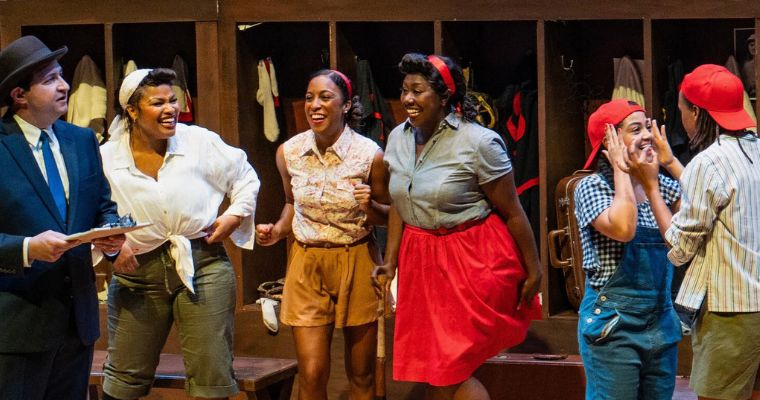
The members of the Red Diamonds rejoice in Layon Gray's play “The Girls of Summer.” (Photo by Christa Ingraham)
Multi-talented theater artist Layon Gray’s play “The Girls of Summer” is as compelling and suspenseful as a John Grisham page-turner. And it’s not because of on-field baseball game drama. Rather, the mystery at the center of Gray’s intense white knuckler takes place off the field.
Specifically, a disappearance happens in “The Girls of Summer,” a fictional play that has some basis in history. And no, you do not have to be a baseball fan or history buff to find meaning and delight in Gray’s drama, set in 1946 Springfield, Illinois.
This mounting by Florida’s oldest Black theater company, (this year celebrating 53 years), runs through Sunday, Feb. 25 at the Sandrell Rivers Theater at the Audrey M. Edmonson Transit Village in Miami.
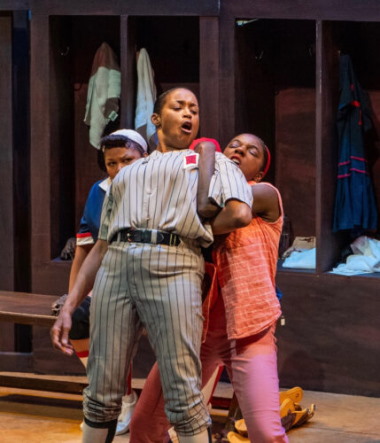
Chasity Hart's Coby Rae watches as Lela Elam's Coach Hicks shows Genisis Summers as Jonetta how tough she is. (Photo by Christa Ingraham)
While some of the performers are making their debut with M Ensemble, others are more experienced with names recognizable from past local productions: The performers are Sophia Kenol, Jenora Hamilton, Janine Johnson, Toddra Brunson, Dina Lewis, Milton Lyles II, Genesis Summers, Lela Elam, Katchana Agama, Mysia Anderson, Rick Urban, and Chasity Hart.
Although it is sometimes it is difficult to hear the actors (they could project more), they are intense yet realistic and demonstrate deft comic timing.
As a group, the actors are believable as a close-knit group of players who horse around and sling sarcasm. In addition, when the characters fight with each other, there is palpable tension and hostility between them. Scenes involving emotional pain and chaos are particularly effective. Nothing appears to be forced.
For the most part, Gray skillfully directs the performers in his original play, which runs about two-and-a-half hours including an intermission, and helps ensure that we are always clear about a scene’s location and time. Gray’s staging is mostly smart However, during at least one scene, the actors play in spaces that are oddly far apart.
For “The Girls of Summer,” which debuted in 2009, Gray drew inspiration from the history of Black female baseball players, as well as the 1992 baseball movie “A League of Their Own.”
In Gray’s piece, Odessa Hicks (Lela Elam) coaches a fictional African American female baseball team, the Red Diamonds. They are to play an exhibition game against the all-white Racine Belles. The latter was a real team in the All-American Girls Professional Baseball League. It featured female players who kept baseball operational while men, including many players, fought in World War II.
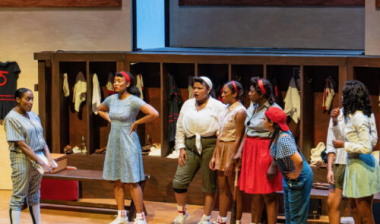
Lela Elam's Coach Hicks addresses the team in Layon Gray's play “The Girls of Summer.” (Photo by Christa Ingraham)
If the Racine Belles sound familiar, perhaps it’s because they were one of the teams featured in Penny Marshall's “A League of Their Own.” While Gray mentions the Belles in his play, they never appear in the piece.
The exhibition game between the Red Diamonds and the Racine Belles is more than just another baseball game for Hicks and her players. In addition, the contest offers a chance for Hicks and the players to gain respect as Black people and women during a time of segregation and inequality between the sexes. Truthfully, today’s hostile environment and violence toward minorities make pieces such as “The Girls of Summer” particularly timely.
Gray’s fictitious Hicks was a barrier-breaking player in the all-male professional Negro Leagues. But one day, an opposing player hurled a pitch that struck her in the knee and ended her playing career. As a result, Hicks grew bitter and became a full-time caregiver to her mentally-challenged daughter, Lucy. Perhaps her relentlessly hard nose style as a coach resulted, in part, from her injury and her thoughts of what could have been.
As Hicks tries to prepare the Red Diamonds to play ball against the Belles, the game itself isn’t the only thing occupying her mind. No doubt, she feels driven by, among other things, personal redemption, a potentially brighter future for Black female athletes, and respect for Hicks’ race and sex. In an often cruel manner, Hicks pushes her players practically to their breaking point. Indeed, no matter how good the players perform in practice, Hicks remains dissatisfied.
“Coach was something else,” one of the players opines. “If ya did good ‘it wasn’t good enough, if ya hit a home run it wasn’t far enough, if ya stole one base, ya should have stole two.”
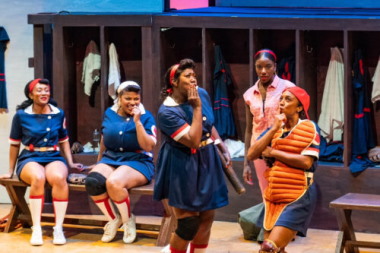
Mysia Anderson, Chasity Hart, Toddra Brunson, and Dina Lewis as members of the fictional Red Diamonds baseball team in Layon Gray's play “The Girls of Summer.” (Photo by Christa Ingraham)
Frankly, the ballplayers don’t appreciate the “tough love” their coach shows them through her meanness and relentless coaching style. Hicks is particularly hard on Betty, a woman lacking in self-esteem and baseball playing skills.
Gray presents the action through flashbacks. In particular, soon after the play begins, a Chicago-area Black journalist named Peter James arrives at the practice field to investigate the disappearance. While he interviews people, the play flashes back to the past, where we witness the events that lead up to the disappearance. It’s a familiar and effective framing device which makes it fairly easy to follow the action without getting confused. James is not only a main character in the play, but its narrator. He alternates between taking part in scenes and addressing the audience.
Fictional baseball executive Mr. West (an impatient Rick Urban) reluctantly grants James permission to talk to the players. At times, he appears that he’s reached the end of his patience. After all, the Red Diamonds-Belles game is quickly approaching, and, as a result, West is a busy man. Part of the humor in the play stems from the fact that West keeps calling James “Jones,” indicating that the executive is not fully present mentally in his interactions with the journalist (an inquisitive and well-spoken Milton Lyles II, whose portrayal is believable frustrated at times).
Gray has Jones present just enough information to inform us and keep our interest without ruining the mystery at the center of the play.
Without giving away too much, we’ll just say that the play touches on themes and topics such as bipolar disorder, sexual orientation, racism, sexism, sacrifice, and the toll taken on groundbreakers.
Each of the cast members creates a distinct and believable character. Indeed, the actors sound as though they are saying the words for the first time, and they are impressively spontaneous.
While most roles on stage require stamina, this is true even more so for Elam as Hicks. The Miami native and New World School of the Arts graduate is a seven-time Carbonell Award nominee, and she won the award twice.
Elam’s Coach Hicks carries the intensity of a drill sergeant, and the performer never fails to command the stage. Impressively, she does so without upstaging the other performers.
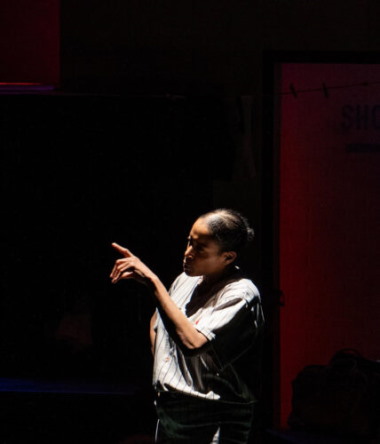
Coach Hicks (Lela Elam) addresses her players. (Photo: Christa Ingraham)
During parts of the play, the coach’s tough exterior breaks and we see the vulnerable, emotional human being behind that rough armor. Elam shines as a stern disciplinarian and as a woman injured physically and emotionally. At times, you want to keep your distance between Elam’s Coach Hicks, while at others you want to comfort her.
The actors perform on Mitchell Ost’s realistic-looking and detailed locker room set. In addition to the set, Ost designed the lighting, which ranges from solid in color to bluish and pinkish to suggest a sunrise.
Shirley Richardson and Dunia Pacheco designed the character-appropriate costumes, while Diego Villada served as fight director.
“Sometimes it’s good for the past…to stay in the past,” a character says.
Contrastingly, Gray has brought the past to vibrant life in many of his plays. The playwright, director, and actor takes little-known African American historical figures, facts, places, and institutions, puts them on stage, and creates compelling drama through engaging theatricality and realistic dialogue.
While “The Girls of Summer” is fictional, Gray sprinkles in historical facts without the proceedings feeling like a lecture.
The Red Diamonds may be fictitious, but thanks to a first-rate cast put together by M Ensemble Company, Inc., they seem as real as people you may know.
M Ensemble’s production of “The Girls of Summer” runs through Sunday, Feb. 25. Performances are at 8 p.m. Friday-Saturday, and 3 p.m. Sunday. Tickets cost $36 each, plus a $4.25 fee. Student and senior discounts are available only at the box office. In addition, special two for one tickets are available for certain nights at Eventbrite.com. For more information, call (305) 705-3218 or go to www.themensemble.com.
Exhibition: A Golden Years Exhibit celebrating 53 years of the theater company is on the second level of the Sandrell Rivers Theater on exhibit from noon to 5 p.m. Monday through Friday through Feb. 29.




